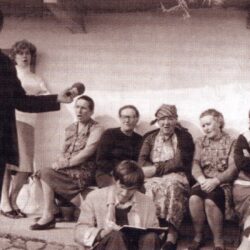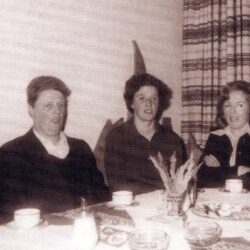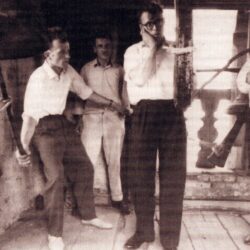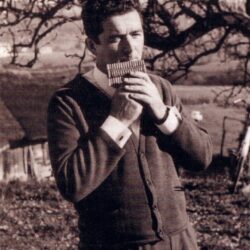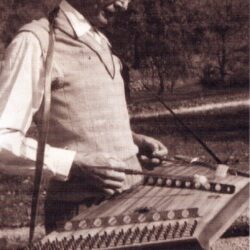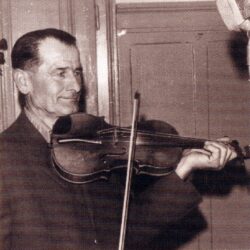Let us Sing a Sweet Song, Let us Play a Tune
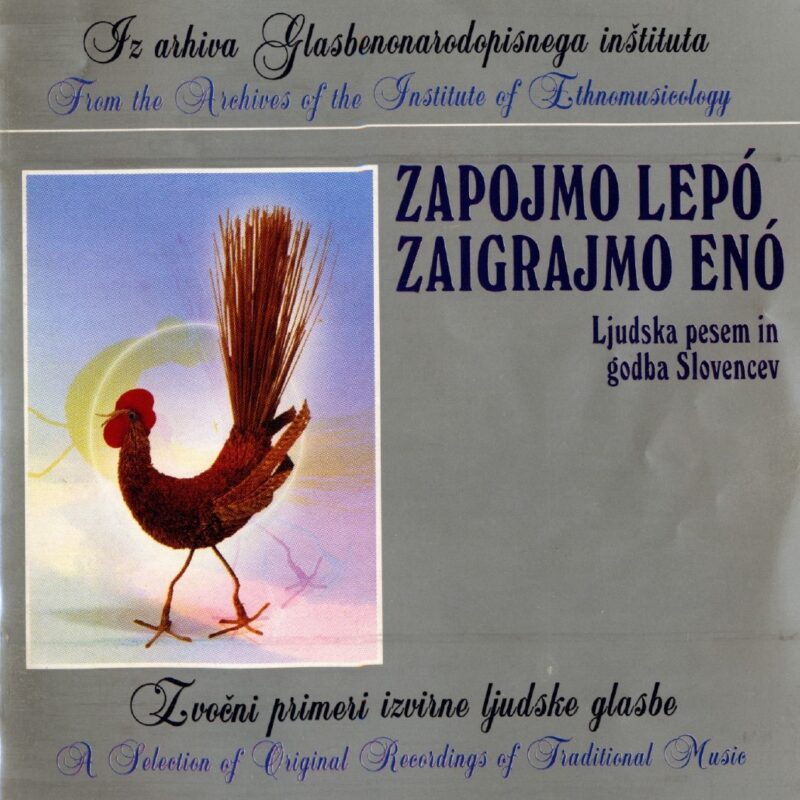
(love song, male group)
GNI M 47.300, Artiče, Štaj.
Recorded: 1997
Youth singing, which was once the custom in Slovene villages, especially on Saturday evenings, has now died out. This was not choral singing, although the singing was for several voices singing in harmony and following fixed rules. Usually one would begin, either with a few words or the entire first verse, and the others would join in. Directing the voices also had a prescribed form, different trom choral singing. Love songs naturally predominated.
A Lad Travelled Far to See His Sweetheart
(ballad, female group)
GNI M 24.080, Vrhpolje above Kamnik, Gor.; recorded: 1961
Women usually sang alone. There are no special women’s songs in our tradition, although it is natural that it was mainly the older women who knew the ballads. Solo singing is not known in Slovenia. A person only sings alone if there is no-one else who knows the song, or when this is demanded by the custom (e.g. the best man at a wedding). Songs were never sung explicitly for listeners. Female singing is for at least two voices, and can be for several voices.
(panpipes)
GNI M 45.770, Podlehnik, Staj.; recorded: 1990
Musician: Franc Laporšek (1930)
Instrumental music was as a rule used to accompany dancing. The instruments are industrial and being a musician was almost a profession. The Slovene tradition includes simple home-made instruments ranging from willow pipes to more complex trstenke, or panpipes. Not everyone knew how to make these. They were made by skilled individuals who then sold them at fairs: panpipes of different sizes, with varying numbers of pipes of varying lengths. Melodies could also be played on them.
GNI M 42.510, Resevna, Štaj.; recorded: 1984
Musician: Ivan Jančič (1909)
From the 19th century onwards it was possible to buy factory-produced harmonicas at fairs. If no musician was present at domestic festivities, dancing was accompanied by the sound of these harmonicas.
I Grew a Little Tree
(love song, mixed group)
GNI M 35.385, Dol. Marsin, Ven.; recorded: 1975
It was the custom, after finishing heavy work which demanded many hands, for the mistress of the house to serve the participants with good food and for the master to supply drink. On such occasions a song might be sung. Everyone who could hold a tune would sing, men and women together.
(love song, mixed group)
GNI M 39.184, Korte/Trögern, Car.; recorded: 1979
Carinthia is generally thought to boast the most harmonious singing, of a kind not find elsewhere. Part singing – with up to five or six voices – is not however a purely Carinthian phenomenon: this type of singing is also found elsewhere in Slovenia. Perhaps it is better preserved in Carinthia, where choral singing is highly esteemed.
GNI M 30.657, Hotedršica, Prim.; recorded: 1979
Musician: Leopold Pivk (1912)
The dulcimer oprekelj is an extremely old musical instrument used in many European countries. In terms of shape and number of strings it is similar to the zither, although instead of being plucked it is struck with a pair of hammers. The dulcimer was still known in Slovenia in the 19th century, when it was used by the musicians who played at dances. The last dulcimer player in Slovenia died at Hotedršica some years ago.
GNI M 32.307, Beltinci, Prkm.; recorded: 1970
Before the appearance of the accordion at the beginning of the 19th century, dances were accompanied by several musicians playing together on different instruments. Such groups still exist in Prekmurje today. Each banda has one member who plays the cimbale, as used by musicians in neighbouring Hungary. The banda is led by a primaš, who plays the violin.
(love song, female group) GNI M 42.956, Beltinci, Prkm.; recorded: 1985
In Prekmurje, singing is mainly in two parts, with the two voices singing i.n thirds or sixths. Sometimes the voices are at intervals of a fourth or a fifth. At the end of the song the leading upper voice can dip below the accompanying voice, producing the characteristic crossing which is a special feature of Prekmurje.
(love song, female group) GNI M 32.649, Sakalovci, Par.; recorded: 1970
Among the Slovenes in the Porabje region unison singing is the custom only in those villages adjacent to Hungarian villages. In general the Slovenes of Porabje sing in two or three parts and for this reason they like to boast that their singing is more beautiful than that of the Hungarians.
GNI M 34.590, Ščulci, Istra
(Croatia)
Recorded: 1973
Musicians: Josip Ščulac (1932) – clarinet, Anton Ščulac (1931) – violin, Anton Paladin (1933) – bass
Ensembles in Slovenia differed considerably, although it occasionally seems as though the accordion superseded all other instruments. Frequently groups would play as a trio, for example violin, clarinet and bass, or fiddle, clarinet and trumpet. Today the bass part is sometimes played on a berda instead of a double-bass, although at one time a small three-stringed bass was used. This appears on painted beehive panels. Musicians in Slovenian Istria used the two-stringed bajs, still used today by musicians in Croatian border villages. To hear how this music sounded we have taken a recording from the village of Ščulci, since it is no longer possible to find a Slovene example.
GNI M 34.296, Bila, Res. (Italy)
Recorded: 1968
Musicians: Livio Micelli (1929) and Giovanni Di Lenardo (1910) – citira, Riccardo Coss (1923) – bunkula
The small bass was more or less the same size as a cello. In Resia, where the citira-bunkula duo is still common today, they use a cello instead of a small bass for the bunkula. The citira is just another name for a violin, though tuned a minor third higher. The people of Resia have their own style of playing and dancing, often in a characteristic alternating 3/4 + 2/4 rhythm.
(love song, male group)
GNI M 45.472, Zatolmin, Prim.; recorded 1989
Folk singing in Slovenia has features not found in classical music. This is proof that folk culture, including music, really is independent and in no sense an echo or imitation of classical, academic culture. One such feature is men’s step singing where the singer who takes the lead begins each successive stanza of the song at a slightly higher pitch. The other singers then quickly join in, in the key indicated, without a tuning fork! The singers thus raise the pitch in steps, as high as they can go.
(love song, female group)
GNI M 40.340, Bila, Res. (Italy)
Recorded: 1982
In out-of-the-way places features can sometimes survive which represent the remnants of an archaic culture. An example of this in Slovene ethnic territory is Resia, which politically belongs to Italy. Although the (2+3)/4 rhythm also appears elsewhere in Slovenia, it is only in Resia that two-part singing with a ‘bordun‘ survives, that is to say, that for the accompaniment there is a lying tone which comes to within a second of the leading tone. The stanzas of Resia songs are regular two-line stanzas but formed in such a way that after the second line there is a compulsory refrain of nonsense words (lalilala), and then a repetition of the second line. Women also sing in this way, and at the end of the song like to shout out.
(love song, female group)
GNI M 30.069, Vel. Varnica, Štaj.; recorded: 1969
Part singing is popularly understood to be the province of boys or men, perhaps because boys used to sing together in the village before going off separately to woo their sweethearts. One proof that folk part singing in Slovenia is not a copy of choral singing is singing na tretko, where the leading voice
(which begins the song) is in the middle, above the accompanying voice, and there is a third voice (or tretka) a third higher. Other dialect names exist for this. The bass is the foundation of this part song. Good tenor singers are capable of a fourth, higher part or firar. In places, e.g. in Haloze, we have also heard women sing na tretko.
A formula for handbell ringing or pritrkavanje
(chiming on ‘standing’ and ‘flying’ bells) GNI M 29.353, 29.350, 29.351/1, Komenda, Gor.; recorded: 1968
That Slovenes are more fond of songs and singing than anything else is testified to by the vernacular expression which describes musical instruments as ‘singing’. It is natural then that bells, which in Slovenia do not only chime the hours but also call the faithful to church or ring out at funerals, and which moreover are a true instrument, should also ‘sing’. Pritrkavanje: chiming, ringing or pealing, or however else it is known, is a custom all over Slovenia, particularly on festive occasions. Two methods are used: flying bells, which means that the great bell is rung with a rope, while the others are struck directly with the clapper or wooden hammer, and standing bells, where all the bells are struck. The strikers follow very varied rhythmic patterns which have their own names. Chiming is in fact a true form of harmony music-making.
(children’s round)
GNI M 47.214, 42.216, 42.217, 42.220, Kranj, Gor.
Recorded: 1997
42.220, Kranj, Gor.; recorded: 1997
Children of the Jakob Aljaž Primary School, Kranj
The folk song tradition also includes children’s spoken texts such as rounds, rhyming taunts, and joking question-and-answer texts. These children’s pieces do not contradict the principle that folk song is always sung and never recited, since their very pronounced rhythm classifies them as songs.
(wedding song, male group)
GNI M 29.448, Zilce, Notr.; recorded 1968
At one time, up until around about the Second World War, a country wedding was not just the affair of the young couple and their families but involved the participation of more or less the whole village, if everything was done according to local customs. Wedding customs everywhere were accompanied by songs which had their own specific place and content. There would be singing for example as the bride left her home, as she arrived at her new home, and at the wedding banquet. Some songs had a wedding-related content. Others were simply songs that were traditionally sung by wedding guests.
(dirge, two women)
GNI M 28.213, Kokošje, Gor.; recorded: 1967
Sung by Ivana Jemc (1904) and Frančiška Peterka (1896)
Today it has become the custom even at town funerals to sing to the deceased by way of farewell; in the countryside singing has always been an important traditional accompaniment to a person’s departure from this world. While it was the custom for the deceased to lie at home until the funeral, relatives, friends and neighbours would gather round and pray, talk, and also sing. Special funeral dirges tell of the transitory nature of life, or bid farewell to the family in the name of the deceased. Other songs have a marked religious content. Ballads were also sung over the body of the deceased, since for the most part these were serious songs. Some, such as the ballad of the tenth daughter (Desetnica), even had tragic endings.
(diatonic accordion)
GNI M 43.819, Gabrje, Dol.; recorded: 1986
Musician: Jože Gorjanc (1937)
When the accordion appeared in the 19′” century Slovene musicians soon saw its usefulness. They took to the new instrument so enthusiastically that the diatonic accordion actually became Carniolan or Old Slovene and even acquired local names (e.g. meh, lajne, fude). Local craftsmen began manufacturing it. The accordion is still a characteristic instrument of Slovene folk music. Today it is known as a frajtonarca.
(E flat clarinet, diatonic accordion, baritone)
GNI M 32.317, Luša, Gor.; recorded: 1974
Musicians: Jaka Gartner – E flat clarinet, Milan Gartner – diatonic accordion, Tone Potočnik – baritone
These days it would be impossible to imagine a good folk ensemble without an accordion. The accordion was usually joined by a clarinet, and sometimes by a violin and a brass instrument.
GNI M 45.677, Vinski vrh, Staj.; recorded: 1990
Played by selected locals
If there was no real musician at a family party but there was someone who could play the accordion, the other instruments were substituted by makeshift instruments. Blowing through a pear leaf or ivy leaf substituted the sound of the clarinet, banging a broom handle on the floor imitated a bass, and pan lids served as cymbals.
(St George’s Day song, male group with piper)
GNI M 24.476, Zilje, Bkr.; recorded 1961. Double pipes player: Franc Grdun (1880)
According to the folk calendar St George’s Day (23/34 April) is the beginning of spring, by which time everything was supposed to be green. At one time St George’s Day was celebrated by house-tohouse singing. This tradition survived longest in Bela krajina, eastern Dolenjska and in Koroška. Reliable data on this custom also exists elsewhere. The St. George’s Day singers were young men. They sang in front of every house and received gifts. In Bela krajina they might be accompanied by a piper playing a double pipe. If they were still youngsters they would deck one of their company in greenery and
‘lead green George’. In eastern Dolenjska they still ‘sing of St George’.
(St Florian’s Day song, male group) GNI M 42.037/2, Precetinci, Štaj.; recorded: 1984
House-to-house singing on the evening before St Florian’s Day (4 May) is the custom in Koroška and certain regions of Štajerska. At one time it was probably even more widespread. Once again the singers are young men. In some places they sing about St Florian; in others they simply burst into song in the kitchen, and for this they receive an egg or search for eggs that have already been prepared. In some regions St Florian’s Day is followed by the reception of older youths into a youth society.
GNI M 27.269, Črnomelj, Bkr.; recorded: 1965
Musicians: tamboura group from Stari Trg ob Kolpi
Tamboura groups began to appear in various parts of Slovenia at the end of the 19th century, as a form of amateur music-making, but have not survived. Tamboura players came to Bela krajina from neighbouring Croatia and there were no local players until the beginning of the 20th century. Today tamboura players are a typical feature of Bela Krajina. Those from Sodevci, for example, are already very well known.
(Midsummer Song, female group with piper) GNI M 24.480, Preloka, Bkr.; recorded: 1961 Double pipes player: Franc Grdun (1880)
Singing about Midsummer’s Day, after which the days start to grow shorter, was at one time more widespread, as is shown by records of songs and other data. Best known are the Bela krajina Midsummer celebrations, because of the special songs and style of singing. Kresnice are girls in groups of four (or more) who sing in overlapping pairs, where each pair begins the next verse before the previous pair have finished singing theirs. According to the local expression they are ‘chasing each other’. They sing from house to house and the words differ not only from village to village but also depending on the conditions in the house (for married couples, single people, etc.). The singers might be accompanied by a piper (up until the First World War there might also have been a bagpiper).
(Epiphany song, male group)
GNI M 43.751, Kostanjevica, Doi.; recorded: 1986
The festivities on the evening before Epiphany (6 January) are still very lively today, and are even enjoying renewed popularity. From surviving data and songs we know that they used to take one of two forms: an enactment of the Adoration of the Magi (based on the gospel) or young men singing in front of every house and receiving gifts. They might be dressed as the Three Kings or carry a star with them containing a light. Today the singers are usually young boys, or in some places girls, while the gifts are donations for missionaries. In some parts, however, it is still young men who do the singing.
(trombone, diatonic accordion, baritone)
GNI M 42.316, Gorenje, Staj.; recorded: 1984
Musicians: Alojz Podgrajšek (1933) – trombone, Gustl Dečar (1938) – diatonic accordion, Janez Dečar
(1940) – baritone
The composition of folk bands was, and very frequently still is, dependent on chance: who can play what instrument, who else is there to play with, what are the opportunities to appear in public. These appearances are mostly dances or village festivities, but musicians never accompany songs. In the Slovene folk tradition songs are unaccompanied, and musicians play only at dances.
Let us sing a sweet song, let us play a tune
Folk song and the music of the Slovenes
Slovenia is a small country lying at the heart of Central Europe, at the crossroads of the Romanic, Germanic and Slavonic worlds. lts landscape is very diverse: in the north it reaches to the Eastern Alps, and in the north-east to the Pannonian lowlands. With the Karst and the coastal region of lstria it extends to the Mediterranean. Thanks to the hills of Štajerska, Dolenjska and Goriška it is known as a wine-producing region. Slovenia’s folk culture is similarly varied. Because of its geographical position Slovenia has always been exposed to various influences which have conditioned its history and its membership of foreign political frameworks. Even today part of its ethnic territory lies outside the borders of the independent Slovenian state. Despite all this we Slovenes have preserved our originality and in terms of culture stand alongside other, larger European nations.
An important part of our culture is folk culture. This includes folk music, which is bound up with customs and traditions and the living Slovene language. There are certain regional particularities but in many other ways our folk music has a pan-Slovene character.
The largest part of Slovene folk music takes the form of songs. Until the Second World War singing played its part in all aspects of everyday rural life and holidays. Following the War the way of life changed significantly. This was partly the result of the growing influence of technical advances in the world. Certain customs have today faded into memory, along with the songs which accompanied them.
Dr. Zmaga Kumer – Ljubljana, October 1998
